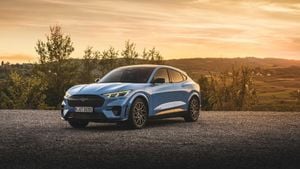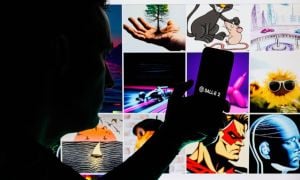Jaguar, the luxury British car manufacturer known for its elegance and performance, is embarking on a transformative path as it unveils its new branding and logo, signaling an intense focus on the electric vehicle (EV) market. This strategic pivot is not only about updating its image but is part of Jaguar's ambitious plan to redefine luxury automotive experiences.
The new branding, presented with great fanfare this week, features fresh visual elements, including the stylized logo, now rendered as "JaGUar". This design combines upper and lowercase letters, representing modern aesthetic values and appealing to younger, fashion-conscious consumers. Accompanying this is the innovative "leaper" cat emblem, which has been reimagined to symbolize dynamism and agility—essential traits for its future EV lineup.
Jaguar’s revival strategy is closely tied to its parent company, Tata Motors. Under Tata’s stewardship, the brand is set to introduce three electric vehicles by 2026, marking its transition to becoming fully electric. Since 2021, Jaguar has halted new internal combustion engine models, allowing it to create what Managing Director Rawdon Glover refers to as "a fire break" between the old and new.
“We need to change people’s perceptions of what Jaguar stands for,” Glover noted, acknowledging the challenges of morphing the brand's identity. The deliberate pause was aimed at delineation, facilitating design innovation and ensuring the vehicles meet the latest standards of luxury and sustainability.
This groundbreaking rebrand will culminate at the 2024 Miami Art Week, where Jaguar plans to showcase the concept of its first electric vehicle—a sleek four-door grand tourer. This vehicle will set the tone for the rest of the lineup, boasting sophisticated design and cutting-edge technology, with premium features expected to provide both comfort and performance.
Alongside the new logo, Jaguar’s marketing now proclaims slogans such as “Delete Ordinary” and “Copy Nothing,” channeling the spirit of its founder, Sir William Lyons, who emphasized originality. The new visual identity not only seeks to align Jaguar with contemporary aesthetics but also aims to rekindle the brand's historical roots of creativity and craftsmanship.
Chief Creative Officer Gerry McGovern emphasized the importance of originality: “The new Jaguar brand is imaginative, bold, and artistic—completely unique and fearless.” This commitment to innovation reflects Jaguar's desire to reestablish its legacy as not merely another luxury car manufacturer, but as pioneers pushing the boundaries of what automotive design can be.
Jaguar's investment indicates substantial financial backing, with £15 billion earmarked for its electric vehicle initiative. This focus aims to address the growing consumer demand for sustainability as climate concerns rise globally. Jaguar's facilities across Coventry, Warwickshire, Solihull, and Castle Bromwich are being enhanced to meet the production requirements of this electric shift.
The dramatic transition occurs as the competitive luxury EV market expands rapidly, with brands like Tesla, Mercedes-Benz, and Audi at the forefront. Jaguar's strategy to stand out relies on its rich history of luxury and exclusive craftsmanship, alongside the bold confidence espoused through their updated branding and marketing campaigns.
Despite the challenges of rebranding, Jaguar remains committed to achieving excellence and sustainability. Glover confirmed, “Reinventing a brand as iconic as Jaguar is no easy task, but we’re committed to creating vehicles not just sustainable, but extraordinary.”
Jaguar’s decision to embrace high-end pricing for its upcoming EV lineup is also reflective of its strategy to target affluent, environmentally conscious consumers. Creating new products aimed at this demographic signals its intent to redefine what luxury means for the electric age, even as traditional Jaguar enthusiasts may grapple with these changes.
With its bold rebranding, Jaguar aligns itself for the future—boldly challenging conventions within the automotive sector. This isn’t just about cars; it’s about shaping the entire narrative of luxury mobility for generations to come. This renewed identity not only invites industry scrutiny but also sets the foundation for success as Jaguar moves forward to reclaim its position as a leader in the luxury automotive world.
There’s already been discussion online about the changes. Social media has seen buzzing debates, especially on platforms like X (formerly Twitter), with fans divided on whether the new approach abandons long-time loyalists. Nevertheless, Jaguar stands by its mission to appeal to younger generations and redefine what’s possible.
While embracing innovation and sustainability is the centerpiece of this transformation, the path Jaguar is treading is undoubtedly ambitious. The road to rejuvenation is steep, especially for such a historically significant brand—a legacy intertwined with British automotive pride. Yet, the potential for innovation and excellence remains high as Jaguar turns the page toward its all-electric future.
This new chapter could reshape not just Jaguar's brand, but also its relationship with the modern auto buyer aimed at sustainability and luxury, blending luxury car heritage with tomorrow's technological advancements.



